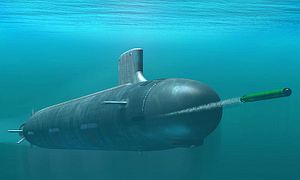The U.S. Navy’s dominant position in undersea warfare can no longer be taken for granted. “Emerging technologies present a serious challenge in that they may empower development of potential rival undersea forces and erode the stealth of U.S. submarines,” concludes a new report by the Center for Strategic and Budgetary Assessments (CSBA). The report, entitled “The Emerging Era in Undersea Warfare,” lays out the rapid changes occurring in the technological realm and how they will affect future combat under waters.
While the report’s author, Bryan Clark, notes that the United States will have the opportunity to be the “first mover” and establish itself as a leader in this emerging new field within undersea warfare, he also unequivocally points out that the U.S. Navy will have to give up its current undersea warfare concepts due to the “vulnerability of today’s principal undersea platform, the manned submarine.” The U.S. must develop “a new family of undersea vehicles,” Clark argues
Although largely unnamed by Clark, he, like most other U.S. naval analysts, singles out the Chinese navy as the principal threat and most likely future adversary of the U.S. naval forces underseas. The Center for Strategic and Budgetary Assessments – filled with the acolytes of Andy Marshall, who very early on in his career recognized the military potential of the emerging Asian superpower and fused it with his obsession of a revolution in military affairs (RMA) – has particularly become a mouthpiece for those seeing U.S. military superiority eroded by the new Asian military juggernaut.
Most senior U.S. defense officials agree with the threatening nature of the Chinese military buildup. “What I’m seeing [now] in foreign modernization, again, particularly China’s, is a suite of capabilities that are intended, clearly to me, at least, to defeat the American way of doing power projection, [the] American way of warfare when we fight in an expeditionary manner far from the United States,” emphasizes Frank Kendall, U.S. undersecretary of defense for acquisition in a recent interview.
As my former net assessment/defense analysis professor once told me: “Defense analysts are paid to be pessimists.” In that sense, a quote from the movie The Three Days of the Condor comes to my mind after reading this new CSBA report. “Boy, have you found a home,” replies Robert Redford sarcastically, after a CIA agent tried to argue about the necessity of playing out hypothetical worst case scenarios. By that, I mean that the hostile intentions of the PLAN are automatically assumed , as is the need for the United States to be able to forcefully project power anywhere on the world’s oceans. It often seems to me that by merging intentions with capabilities, perhaps through a selective reading of Chinese military literature, one is able justify just about any future naval conflict scenario as long as the acronyms A2/AD (anti-access/anti-denial) and the word “network” are somewhere included in the analysis.
However the larger picture aside, from a technical and operational perspective, the report is fascinating. Clark singles out the rapid increasing in computer processing — big data –to be one of the biggest game changers (e.g., in helping to run sophisticated oceanographic models) and permeating all aspects of a new form of undersea warfare. He cites three technological advancements in particular:
New ASW capabilities to find and attack undersea platforms;
Undersea platform improvements that will enhance their endurance and stealth; and
New undersea weapon, sensor and communications systems.
From an operational point of view, the report notes that “manned submarines will likely need to shift from being frontline tactical platforms like aircraft to being host and coordination platforms like aircraft carriers.” This would be a big change from how large portions of the U.S. submarine fleet are used today. The aircraft carrier comparison would also imply that future submarines would need to be bigger than today’s Virginia-class submarines, in order to accommodate a host of new systems, as well as an array of unmanned vehicles and weapons.
Over the next year CSBA will further explore trends in undersea warfare technology; The Diplomat will follow this discussion closely — so stay tuned!

































